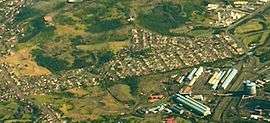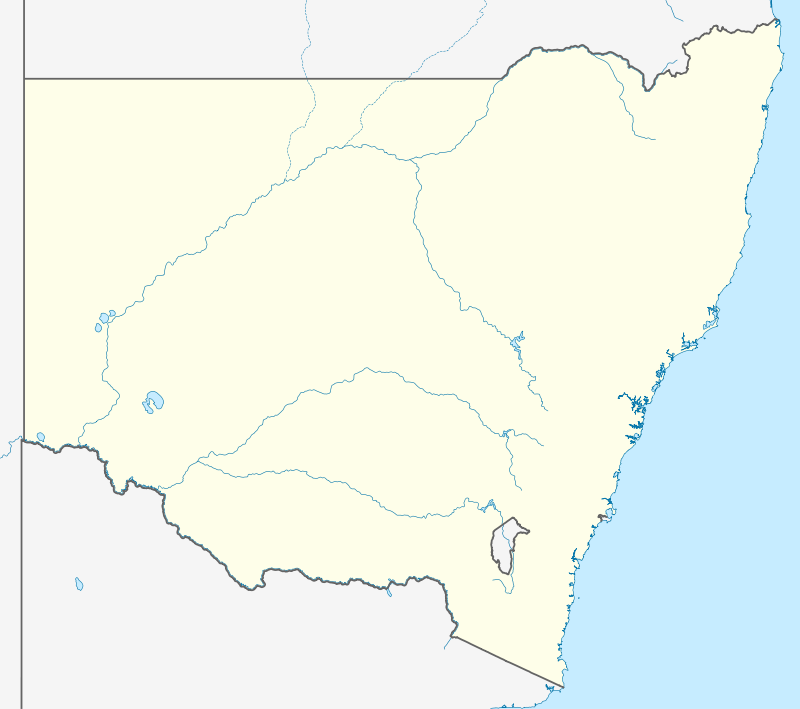Cringila, New South Wales
Cringila is a densely populated southern suburb in the city of Wollongong, New South Wales, Australia. The suburb is bounded by Berkeley, Unanderra, Lake Heights and Warrawong.
| Cringila Wollongong, New South Wales | |||||||||||||||
|---|---|---|---|---|---|---|---|---|---|---|---|---|---|---|---|
 Aerial photo from east | |||||||||||||||
 Cringila | |||||||||||||||
| Coordinates | 34°28′16″S 150°52′19″E | ||||||||||||||
| Population | 2,198 (2016 census)[1] | ||||||||||||||
| • Density | 845/km2 (2,190/sq mi) | ||||||||||||||
| Established | 1928 | ||||||||||||||
| Postcode(s) | 2502 | ||||||||||||||
| Area | 2.6 km2 (1.0 sq mi) | ||||||||||||||
| Location | 6 km (4 mi) from Wollongong | ||||||||||||||
| LGA(s) | Wollongong City Council | ||||||||||||||
| State electorate(s) | Wollongong | ||||||||||||||
| Federal Division(s) | Whitlam | ||||||||||||||
| |||||||||||||||
The suburb is planned on a north-south residential/commercial strip and the east west streets that adjoin it, making a rectangular pattern.
Cringila Community Park is a 78 ha site purchased by Wollongong City Council after residents defeated a proposal by BHP to use the land as a dump for industrial waste. Its main purpose is to regenerate the local area's natural wildlife. Surrounding Cringila's primary school is a protected rain forest.
A fraction of Cringila is the Port Kembla steelworks, which is a major local employer. This led to an influx of ethnic groups, primarily Macedonian, Portuguese, Turks and Lebanese. This in turn transformed the demographics of Cringila significantly and at the 2001 census more people lived in households where Macedonian was spoken (31.8%) than in households where only English was spoken (24.6%), making it the only suburb in Australia where this was true.[2] However, at the 2016 census only 18.5% of the population lived in households where Macedonian was spoken and 40.2% lived in households where only English was spoken.[1]
History
The word Cringila is an Aboriginal name - the town was formerly called Steeltown. In 1928 the first blast furnace opened up at the Port Kembla steelworks.
In 1935 the first public school opened, it was known as Steel Town School. In 1957 Cringila Public School opened.
Shopping
The main operating shops include Abdul's Butcher, the Cringila Hotel, a few burek shops, a newsagency, a pharmacy and convenience store. Other businesses include a petrol station, kebab shops, and a florist.
Sport
Cringila also has a local football (soccer) team which participates in the local Illawarra Premier League. They are supported strongly by the Macedonian community of Cringila and Wollongong. They play their local games at their home ground at John Crehan Park, Merrett Avenue, Cringila. In 2008 Cringila had finished 4th in the local Illawarra Premier League and also won the Corrimal League cup which also led to greater success in winning the Bert Bampton Cup. Cringila Lions have a strong rivalry with Wollongong United also backed heavily by the Macedonian community.
Transport
Cringila railway station in on the Port Kembla Branch of the South Coast railway line.
Demographics
At the 2016 census, Cringila had a total population of 2,198 with 1,121 (52.0%) born in Australia and a median age of 36. Their country of birth was as follows:[1]
| Country of birth | Number | Percentage of total inhabitants |
|---|---|---|
| Australia | 1,121 | 52.0% |
| North Macedonia | 272 | 12.6% |
| Lebanon | 106 | 4.9% |
| Syria | 54 | 2.5% |
| Turkey | 48 | 2.2% |
| Portugal | 41 | 1.9% |
40.2% of people spoke only English at home. Other languages spoken at home included Macedonian 18.5% and Arabic 16.1%. The most common responses for religion were Islam 23.5%, Catholic 16.7%, Eastern Orthodox 14.9%, No Religion 14.0% and Christian, not further defined 8.1%. [1]
See also
- Macedonian Australian
References
- Australian Bureau of Statistics (27 June 2017). "Cringila (State Suburb)". 2016 Census QuickStats. Retrieved 16 July 2017.

- Australian Bureau of Statistics (9 March 2006). "Cringila (State Suburb)". 2001 Census QuickStats. Retrieved 16 April 2015.